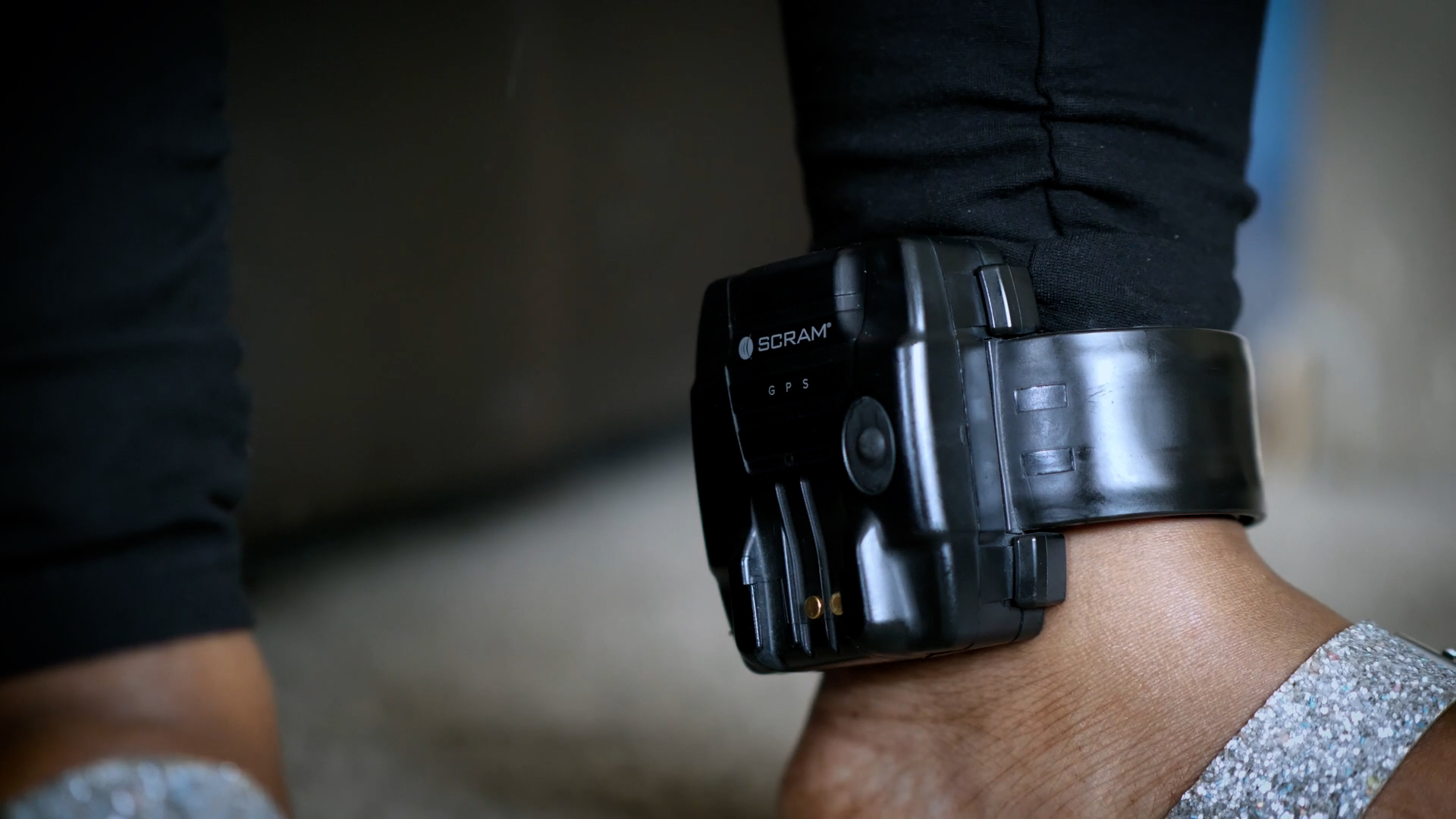Our Position
Like cash bail, pretrial electronic monitoring is a flawed policy that does not enhance public safety or improve the likelihood that a person returns to court. Instead, it punishes people with low incomes, disproportionately impacts people of color, and creates administrative burdens. If used, this mode of surveillance should be strictly regulated and used only as a last resort before detention to prevent willful flight or imminent harm to identifiable persons.
What is Electronic Monitoring?
Electronic monitoring is a form of government surveillance that courts are increasingly using as a condition to release people who have pending cases in criminal court. A person’s location is tracked using wrist or ankle bracelets, and the individual is often responsible for any fees associated with it. Like cash bail, it has become standard practice for courts to order electronic monitoring without regard for a person’s ability to pay for the costs of monitoring or a robust inquiry into whether it is warranted in the first place.
Although electronic monitoring does not fully curtail someone’s ability to move through society in the same way that jail does, it has incapacitating and dehumanizing effects – the hard plastic against bare skin commonly causes sores and bleeding, not to mention the unseen psychological effects that come from having a person’s privacy invaded through continuous surveillance. A person subjected to electronic monitoring must adhere to extremely restrictive rules that limit their movements. Many people on electronic monitoring are subject to curfews, prohibited from entering or leaving certain areas, and forced to remain confined in their homes, sometimes 24/7.
Although most people on electronic monitoring can maintain or seek employment, daily charging requirements can impede a person’s ability to work for a sustained shift without returning home or tending to their device. A dead battery can trigger an arrest; so can going into an area where the GPS signal is interrupted. In addition, the mere sight of an electronic monitor on a person’s wrist or ankle can cause a potential employer to make assumptions about a job candidate when in fact they are still legally presumed innocent. Indeed, wearing an ankle monitor is like a modern scarlet letter.
In courts across the country, judges overuse electronic monitoring, assign it even to people with no criminal history, no history or likelihood of flight, and to people charged with non-violent felonies and misdemeanors. Despite the lack of evidence on the effectiveness of electronic monitoring, the number of people being monitored has more than doubled since 2005. On any given day in America, approximately 125,000 people are on some form of electronic monitoring, with some experts suggesting that number could be far higher. Every state in the country utilizes some form of electronic monitoring.
Electronic Monitoring Has Not Been Proven Effective
Officials across the country are opting to place huge numbers of individuals on electronic monitoring when they release them pretrial. The rationale for the use of electronic monitoring is simple but misguided – individuals who are under supervision, they say, will be deterred from engaging in any criminal activity because they’re being watched. The truth is, there is no evidence that supports this hypothesis. The only studies that do exist show that electronic monitoring is no more effective at preventing crime and minimizing flight than other forms of pretrial supervision, like phone or in-person reporting to a dedicated supervisory officer.1 Grommon, E., Rydberg, J., & Carter, J. G. (2017). Does GPS supervision of intimate partner violence defendants reduce pretrial misconduct? Evidence from a quasi-experimental study. Journal of Experimental Criminology, 13(4), 483-504. The things we worry about the most – a mass shooting, a murder, which are extremely rare events – are largely unpredictable and not preventable with electronic monitoring.
The use of electronic monitoring in most instances is both unnecessary and overly restrictive. The vast majority of individuals released pretrial are not charged with additional offenses when they are released, they appear at most of their court dates2Office of the Chief Judge (2019). Bail Reform in Cook County: An Examination of General Order 18.8A and Bail in Felony Cases. State of Illinois, Circuit Court of Cook County., and other less restrictive conditions of release like phone reporting or in-person reporting can often serve the same purpose of minimizing risk to public safety and flight.
Given the lack of data, electronic monitoring should only be used if a court finds that someone poses a substantial and imminent risk of serious bodily harm to a reasonably identifiable person or a substantial and imminent risk of willful flight, and that no less restrictive condition, or combination of conditions, could reasonably mitigate the identified risk.
Electronic Monitoring Punishes People with Low Incomes and Creates a Two-Tiered System of Justice
The use of electronic monitoring perpetuates a two-tiered system of justice – one for those with financial resources and one for those without, which, like cash bail, is fundamentally unfair because money should not determine who is free and who is not.
In most jurisdictions, people assigned to electronic monitoring are required to personally cover the administrative costs of their own surveillance, which can be as much as $1,400 per month. A person should not have to be able to afford the cost of monitoring to be released – yet, across the country, judges rarely hold ability-to-pay hearings to determine the impact of electronic monitoring’s financial burden, instead making the wrongful assumption that the high price of the associated administrative fees will not be consequential to them. In some jurisdictions, a person will not be released if they cannot immediately pay the daily costs to wear a monitor. A better approach would be one where these costs are waived if a person cannot afford them. Missed payments – which result in the imposition of late fees, penalties that gain interest, and civil judgments – can lead to a never-ending cycle of debt and court involvement.
Further, those on electronic monitoring pay these fees until their case is resolved; this can take months or even years. To mitigate the financial impact of long-term electronic monitoring, it is important to have periodic reviews at regular intervals or when there is any change in a person’s circumstances to allow for frequent assessment of the necessity of the monitoring while also enabling judges to impose less restrictive conditions of release as appropriate instead.
For the people with low incomes who make up the majority of the pretrial population, the associated costs of monitoring are entirely unaffordable. Even if a person’s charges are dismissed or they are acquitted, they are forced to pay the fees associated with the monitoring and, unlike cash bail, are never reimbursed for those costs if they meet all their legal obligations. Effectively, this means that many people subjected to electronic monitoring are forced to pay a tax to maintain their freedom. This should not be the case. If a jurisdiction chooses to use pretrial electronic monitoring, it should cover the associated costs for individuals.
Electronic Monitoring Disproportionately Impacts People of Color
Available evidence suggests that the use of electronic monitoring disproportionately affects people of color given their disproportionate representation in the criminal legal system. Nationally, people of color are arrested and detained at far higher rates than their white counterparts, even after controlling for relevant factors. As a result, they are also subject to higher rates of electronic monitoring. Wayne County, Michigan, which includes Detroit, exemplifies these disparities, with Black people two times more likely than their white counterparts to be placed on electronic monitoring. Similarly in Cook County, Illinois, which includes Chicago, Black people comprise one-quarter of the population but make up two-thirds of the people on electronic monitoring. Electronic monitoring is proving to be another mechanism that perpetuates an ineffective, excessive, and discriminatory criminal legal system.
Electronic Monitoring Burdens Government and Incentives Profit-Driven Interests
For parole, probation, and pretrial supervision officers, the increased use of electronic monitoring strains their workload at a cost to municipalities. These devices are subject to high rates of false alarms as a result of device malfunctions and other inaccuracies which limit the reliability and utility of their use. Instead of connecting people to helpful social services or providing other forms of support, these officers spend much of their workday responding to false alerts. If officers are inundated with repeated false alerts, they may become disinvested from each alert simply by being conditioned to ignore false alarms.
Additionally, much like private prisons, the privatization of electronic monitoring creates perverse financial incentives for governments to expand its use. Often, when governments outsource services to private entities, they become bound by contracts that incentivize overuse by discounting services based on quantity. Because the more a government relies on privatized electronic monitoring, the less costly it becomes for them to use it, they may be more inclined to assign it to people who don’t actually need it.
Conclusion
While The Bail Project opposes the use of pretrial electronic monitoring, we recognize that many jurisdictions will continue using it as an alternative to pretrial detention in a jail. To mitigate the harms of electronic monitoring, courts should be required to ensure that people accused of crimes are not financially responsible for the costs of any monitoring that the court requires. If used, states should establish rigorous procedural protections where a high standard of evidence must be met and where other less restrictive conditions of release should first be considered before such surveillance can be ordered by a court.
Thank you for your valuable attention. The urgency and complication of the cash bail crisis requires meaningful participation to create real change – change that is only achieved through the support of readers like you. Please consider sharing this piece with your networks and donating what you can today to sustain our vital work.












